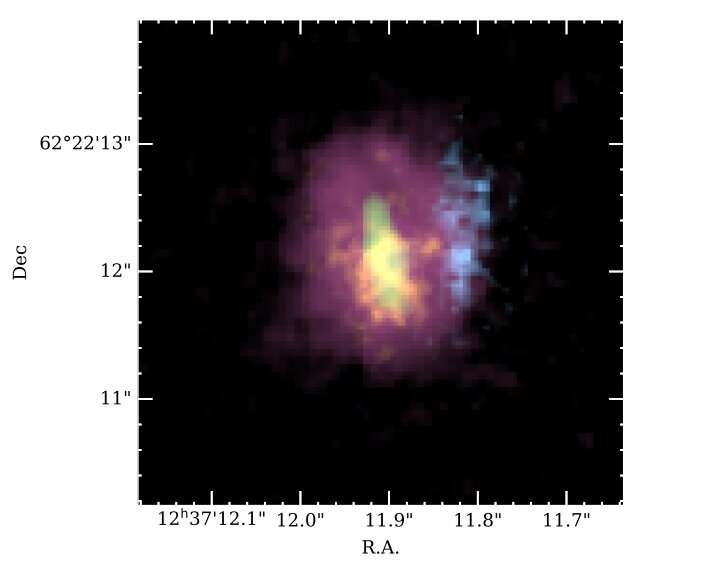May 10, 2023 report
This article has been reviewed according to Science X's editorial process and policies. Editors have highlighted the following attributes while ensuring the content's credibility:
fact-checked
preprint
trusted source
proofread
JWST observations unveil stellar structure of star-forming galaxy GN20

An international team of astronomers has used the James Webb Space Telescope (JWST) to observe a luminous dusty star-forming galaxy known as GN20. Results of the observational campaign, published April 26 on the arXiv preprint server, deliver important insights into the stellar structure of this galaxy.
At a redshift of 4.05, GN20 is one of the most luminous dusty star-forming galaxies (DSFGs) known to date. GN20 is located in a protocluster or galaxy overdensity, has an infrared luminosity of some 18.6 solar luminosities, and a star formation rate (SFR) of about 1,860 solar masses per year. The molecular gas distribution in this galaxy shows a clumpy stellar structure with a diameter of approximately 45,600 light years and kinematics consistent with that of a massive rotating disk.
Recently, a group of astronomers led by Luis Colina of the Spanish Astrobiology Center in Madrid, Spain, decided to perform mid-infrared observations of GN20, aiming to shed more light on its properties. For this purpose they used JWST's Mid-Infrared Instrument (MIRI).
"GN20 JWST imaging was obtained on November 23–24, 2022, using the MIRI imager (MIRIM, Bouchet et al, 2015) in the F560W filter as part of the European Consortium MIRI Guaranteed Time (program ID 1264)," the researchers explained.
The observations found that GN20 has a stellar structure characterized by a luminous (with an absolute magnitude of -22.35) unresolved nucleus and a diffuse extended envelope. This stellar structure is forming new stars at a constant, high rate of about 500 solar masses per year, for a period of 100 million years.
The nucleus is less than 2,600 light years in size, carries 9% of the total flux and coincides with the compact, cold dust nuclear emission. The stellar envelope has an effective radius of about 11,740 light years, and its position agrees with that of the carbon monoxide molecular gas, but its centroid is offset by approximately 3,300 light years from the stellar nucleus. This offset may be a result of a recent gravitational encounter or merger.
By analyzing the JWST images, the team also identified additional faint stellar clumps that appear to be associated with some of the ultraviolet and carbon monoxide-clumps. Moreover, the astronomers found that the stellar nucleus appears to have the highest concentration of cold dust but not the largest concentration of molecular gas.
Summing up the results, the authors of the paper noted that GN20 has all the properties needed to evolve into a massive quiescent galaxy at intermediate redshift.
"It is a large, luminous galaxy at z = 4.05 involved in a short and massive starburst centered in the stellar nucleus and extended over the entire galaxy, out to radii of 4 kpc, and likely induced by the interaction or merger with a member of the proto-cluster," the researchers explained.
More information: L. Colina et al, Uncovering the stellar structure of the dusty star-forming galaxy GN20 at z=4.055 with MIRI/JWST, arXiv (2023). DOI: 10.48550/arxiv.2304.13529
Journal information: arXiv
© 2023 Science X Network



















